Kit Chapman looks at how people are tackling the hidden biases holding sections of society back in pursuing a career in science
In 2009, as US President Barack Obama’s staff started work, a third of them noticed that they were not being invited to crucial meetings. And when they were included, their contributions were often overlooked. They were all women – and they decided to act. The staffers began a strategy called ‘amplification’: when a woman made a point in a meeting, another would repeat it, giving credit to their colleague. The move worked: Obama noticed and began calling on more women.
Being overlooked is an experience familiar to many in science. In a 2014 study of minority ethnic women in science, 100% of those surveyed reported encountering gender bias.1 Yet there no suggestion that such discrimination was deliberate. Rather, it is often the result of unconscious, also known as implicit, bias. These are attitudes to race, gender and sexuality ‘programmed’ into us by society. These biases affect everyone, regardless of their own personal characteristics – and have a major impact on everyone’s working life. If you’re a white man, chances are it’s a positive impact; for women, the LGBT community or people of non-white ethnicity, it’s often negative.
There is still old-fashioned prejudice that women aren’t good for science
Joan Williams, Hastings College of the Law
‘Everyone’s unconscious biases are wrapped up in identity,’ Michelle Ryan, a social and organisational psychologist at the University of Exeter in the UK, explained at the Collaborating for gender equality in STEM conference in May this year. ‘You get men saying “I don’t know why I’ve got to think about gender”; it’s because they’re invisible, part of the majority. Privilege is invisible.’
‘There is still old-fashioned prejudice that women aren’t good for science,’ adds Joan Williams, founding director of the Center for WorkLife Law at the University of California’s Hastings College of the Law in the US. ‘But we need to get beyond the idea that the kind of bias keeping women back is the “I don’t like women”, self-conscious hostility. That’s not the style of discrimination in the 21st century.’
The face of bias
Signs of these behaviours in science are everywhere, starting in schools and continuing through all levels of the career ladder. In 2011, 49% of mixed-sex schools in the UK had no girls studying physics at A-level.2 In 2012, a study of science departments in US universities found that applications for a lab manager position with a male name were rated significantly more competent and hireable than an identical application with a female name; the men were also offered a higher starting salary and more career mentoring.3
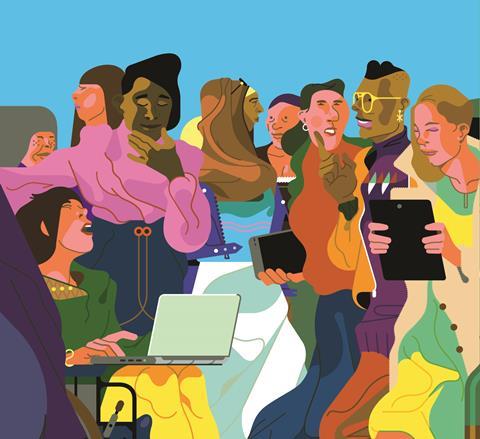
These biases are not exclusive to any particular gender or type of person: a 2017 study found a panel with at least one woman assessor was less likely to recommend a female candidate for a tenure track position than an all-male panel.4 ‘Don’t be fooled by “We appoint on merit”. Whose merit?’ asked Barbara Stocking, president of Murray Edwards College at the University of Cambridge, UK. ‘Often people are judged in very particular ways … it’s hardly surprising [so few women are in science] when men have been writing the exams for 800 years,’ she explained at the Collaborating for gender equality in STEM conference.
Once in a science career, women earn less, are less likely to get promoted or receive letters of recommendation and are more likely to quit altogether.5 There is also evidence women face constant doubts over their ability. ‘About two-thirds of women have to prove themselves more than their colleagues,’ Williams explains. ‘And 80% of men said having children did not change their colleagues’ perception of their work commitment or competence, compared with 55% of women. We also found that women were much more likely than men to report pushback for assertiveness. Behaviours that are often taken as a mark of competence in men are penalised in women. The tightrope is that they are pressured to behave in masculine ways to be taken seriously, and pressured to behave in a feminine way to be liked.’
There needs to be attention paid to race as well
Joan Williams, Hastings College of the Law
Nor is the impact of unconscious biases limited to gender when creating barriers to a career in science. According to the US National Academy of Sciences, of the 23,000 US chemistry graduates in 2014, only 1000 were Latino and 730 were African–American, compared to around 16% and 12% of the US population respectively.
‘There’s so much attention to gender in science, but there needs to be attention paid to race as well,’ Williams notes. ‘There’s a shockingly high level of women scientists of colour – in white lab coats – being mistaken for custodial or administrative staff: 48% of black and 47% of Latina women scientists.’1 The same study found Asian–American women were often assumed to be foreign and complimented on their ability to speak English, while black women were regularly confronted with negative stereotypes, such as being asked if they had relatives in prison.
These biases are made worse through intersectionality, when two different biases (for example, gender and race) can combine. While two-thirds of women feel they are repeatedly required to prove themselves, the figure rises to 77% in black women scientists; similarly, 61% of Asian–American scientists report backlash for being assertive, while 60% of Latinas felt they were not free to express anger at work. Both rates were higher than for all other ethnicities. Black women were also more likely to report a sense of loneliness and isolation.1
‘It’s not just about a single axis of oppression,’ Johanna Lukate, a PhD student in the Department of Psychology at the University of Cambridge, said at the conference. ‘When talking about who they are, women [of colour] have to highlight their identity – for example black Caribbean – before getting on to the point they care about … we shouldn’t see race as essentialising; it is a social construct .’
Implicit understanding
‘For whatever social category [you can think of], there are attitudes or biases about it,’ says Jordan Axt, graduate student at the University of Virginia. Axt is part of Project Implicit, an international collaboration of researchers that has been studying unconscious biases for almost 20 years. Axt’s focus is on the changing attitudes toward the transgender community in the workplace – but while these attitudes seem to have shifted rapidly in society, others are more ingrained, particularly when it comes to race. ‘Looking at the US, in the past 9–10 years we’ve found really no change [in bias toward race]. But there have been changes in bias toward sexuality.’
Axt’s group use an implicit association test (IAT) to measure bias, which can be taken online (see box The test below). The test uses reaction times to measure how words are associated with particular concepts – for example, good words with men, negative words with women, and then vice versa. ‘It infers how strongly those concepts are tied together in your memory. Most people, 65% of people, say they don’t have a cognitive difference. But you can see at a reaction level how they are associated. It’s validated, it’s a good measure – though like every popular measure it has its critics.’
Talking about unconscious bias can be divisive if you don’t do it in the right way
Suzy Firkin, Wise campaign
Axt stresses that an IAT is not a definitive declaration of whether someone holds a particular unconscious belief. ’These are not lie detectors. We can’t say “OK, this means with 100% accuracy you’re biased”. It’s more of an insight that there are associations that exist in your mind that can still be related to your behaviour that you might not be consciously aware of. It highlights all the things your mind does. Your mind is doing a lot unconsciously, so you can see what is at play in the social world.’
While there is some evidence that being aware of biases can help, it is only the first step. ‘Talking about unconscious bias can be divisive if you don’t do it in the right way,’ warns Suzy Firkin, principle associate at the Wise campaign for gender balance in science, technology and engineering in the UK. ‘As with anything we learn, unless you can take that away and use that in your day to day life, and you have some simple and practical tools you can use, it’s not going to stay with you.’
The test
Chemistry World asked its staff and five scientists with a particular interest in diversity to take a series of implicit association tests and to discuss what they found out about their own personal unconscious biases. Each person was asked to take three IATs: how they associate gender with science, preference for faces of European or African ethnicity, and preference for straight or gay sexuality.
Why did we take these tests? Partly because it was hard to resist discovering what implicit associations we may hold. More importantly, because it goes to the heart of journalistic values – honesty, accuracy, balance, fairness. We have to be willing to challenge our understanding and treatment of gender, race and sexuality in our coverage. From here, we will be working continuously to ensure that Chemistry World is a place where anyone involved in chemistry feels included and respected and represented.
Adam Brownsell, editor Chemistry World
Polly Arnold (professor of chemistry; white, woman, bisexual)

‘[My childhood] engendered a determination to not conform, and a pride in being different, which has helped me be comfortable with being queer, and to continue with science as a career. It has also no doubt helped shape the sort of research goals I still set now. I find it empowering to see this sort of precise data about my behaviours set out. These tests are so quick and easy, yet thought-provoking.’
Anonymous (scientist; black, male, heterosexual)

‘What was evident is that your personal experiences influence your responses in these tests, not what your personal views are. In my case, I’ve had negative experiences from people based on my ethnicity, so it’s unsurprising that I have an unconscious bias towards people who look like me and have shared this experience.’
Alice Gray (science blogger; white, female, heterosexual)

‘I found the tests really interesting… as someone who works hard to break bias and raise awareness for internal bias, this inspires me to work harder to break the associations we form through the media we consume.’
Anonymous (scientist; black, female, undisclosed)

‘Given that I was raised and live in America, I would have expected a preference for the dominating systems of oppression… but that is not what the results show. I think this is due to work on my part to overcome, quite frankly, the bullshit I was indoctrinated with growing up and beyond. I think sometimes our jobs as adults is to de-program all the toxic and wrongheaded views that infect us, starting when we’re kids.’
Mark Smith (scientist; white, male, heterosexual, disabled)

‘I will have to consider how these unconscious biases are affecting the decisions I make and try to negate them without being positively discriminatory. I also under took the disability test (as I am disabled), and found that I had no automatic preference between disabled and able-bodied people, but this response was not in the largest group [of all those who have sat the test]… I wonder if there is something about empathy that affects our individual unconscious biases.’
Adam Brownsell (editor, Chemistry World; white, male, heterosexual)

‘I studied literature and art – where women were under-represented for centuries – so I’m surprised that I didn’t associate male with arts particularly as my experience in science has felt a lot more gender balanced then my time in art ever did. I was expecting no racial preference – but if I did express one, I would have assumed it would reflect my own identity as a white European. I can’t really fathom my pro-gay bias – and the fact it is moderate rather than slight is even more surprising.‘
Neil Withers (features editor, Chemistry World; white, male, heterosexual)

‘I’m not hugely surprised – considering my ‘traditional’ background and education – but I am a bit disappointed to see moderate to strong biases in all three categories. Having read about implicit biases in the past, I hope I’ve been able to combat them through conscious choices.’
Jennifer Newton (RSC content editor, Chemistry World; white, female, heterosexual)

‘It’s easy to call out obvious instances of racism, sexism and homophobia but subtle, unconscious prejudices are probably just as damaging to society – especially when they belong to people, like me, who think discrimination is something other people do. Plus I’m glad to see that, in spite of the constant societal messages about science being a male pursuit, I more strongly associate women with science than men. ’
Algorithm inequalities
These tools start by creating barriers within workplaces to prevent the impact of biases – particularly when it comes to hiring. And it’s not enough to assume that a computer will be neutral; the latest research shows that, because the systems have been coded by people, recruitment software cannot be relied upon to be free from bias.7 ‘There’s a growing body of evidence that the algorithms that are being used for hiring have coded in the same patterns of bias,’ says Williams. ‘It’s literally in the algorithms.’
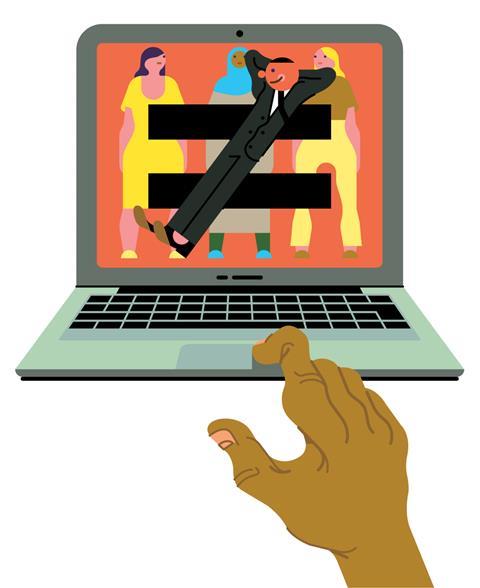
Part of the solution, says Firkin, is to keep bias in mind. ‘Just recognising that we’re all biased, but we all want to do the right thing, just reminding people at the beginning of a recruitment process is enough to alter behaviour. Put some pointers on your front sheet when you’re preparing an interview – it’s very effective, it doesn’t need to be complicated. Similarly, when creating a job spec or role definition, there are tools that allow you to scan language to ensure it is not biased.’
Such language can be subtle but important. ‘When we talk about being “dominant” or “competitive”, “fast-moving” or “thrusting” environments, that’s macho language,’ Firkin says. ‘With “community working”, “team working” and “relationship building” on the feminine end of the spectrum.’ Job adverts can also show bias towards candidates based on age rather than ability, with words such as ‘dynamic’ or ‘recent graduate’ being potentially discriminatory to older workers, while requiring a number of years of experience potentially disadvantaging younger applicants.
The University of Edinburgh in the UK has adopted policies to address this, according to Lesley Yellowlees of the chemistry department. University staff went through rigorous unconscious bias training to identify discriminatory behaviour they might have towards potential recruits. ‘You look at someone’s CV and try to work out how old they are, and I’m afraid I do it as much as everyone else,’ Yellowlees says. To combat this, the university removes dates from CVs to ensure that candidates are simply measured on whether they are competent for the job or not. ‘And if anyone brings up age during the process they’re reminded to stop – whether at shortlisting, long listing or interview.’
A more junior person will mentor an executive in a formal relationship
Jill Armstrong, Murray Edwards College, Cambridge
To address bias in recruitment, Williams recommends a multifaceted approach that includes properly defining adverts not to exclude women, blinding gender and race information on CVs, providing forms for structured feedback. For universities, she suggests introducing dual-hiring where both partners in a relationship are recruited, and even changing the way scientists negotiate lab start-up costs. At the University of Michigan, US, one candidate reported being asked what equipment they would need for their lab – which allowed for a reasoned discussion with the chair of the department rather than an aggressive negotiation, which are typically biased towards white men.1 But recruitment is only one issue. Williams recommends companies introduce ‘bias interrupters’, an evidence-based model for tackling bias at the systemic level. This approach seeks to address shortcomings in traditional diversity programs, particularly a lack of concrete goals (and accountability for reaching them) and an overly narrow focus on hiring rather than addressing the complex range of biases which collectively contribute to diversity issues.
Within any group, systems can also be created to ensure biases are minimised, Jill Armstrong, a research associate at Murray Edwards, explained at the Collaborating for gender equality in STEM meeting. One idea that has found success is reverse mentoring, where an early career woman or person of colour acts as the mentor for a member of the senior team. ‘The idea is that a more junior person will mentor an executive in a formal relationship. Both share information … small things make a big difference.’ Such schemes, Armstrong says, allow both people to get an insight into their workplace and address biases. Armstrong also recommends programmes requiring walkabouts between teams or covering the job of another person, or having policies that external conferences and events will not be attended unless they have a reasonable gender balance.
Importantly, workplaces need to ensure any culture of inappropriate behaviour is quashed. Those in which bullies thrive or people shout to be heard have been shown to systematically disadvantage women and people of colour of either gender; either they are forced in to silence or face a backlash for standing up for themselves.
Leading by example
Support from others outside any marginalised group also helps. Armstrong recommends that others can copy the Obama staffers, and ensure that ideas are credited. ‘Form alliances, so it isn’t just about you. Make sure that things don’t go unspoken, point out the source of idea if it’s come from a person from a different gender [or race]. The more people get behind this, the more progress we will make.’ However, she also warns that going too far in the other direction – benevolent sexism – can be equally harmful. ‘This happens a lot where there’s an age difference. It’s well-motivated, but takes away control. For example, not inviting a woman to go to a conference as she has children and you assume she wouldn’t want to – a well-intentioned man can kill a career with kindness.’
Fit makes you feel like you have a good work–life balance
Michelle Ryan, University of Exeter
Crucially, any change made to counter unconscious biases should not take away an individual’s own sense of identity; rather, it is about supporting them so they feel they belong. ‘Recently, there has been a shift toward choice: what sort of choices make people feel insecure?’ Ryan explains. Her current focus is on why women drop out of science career pathways, with a particular emphasis on how a person perceives themselves. Often, women who have left the career ladder – for example for family commitments – do not return, citing work–life balance. Some organisations have taken steps to make returning to work easier; Somerville College at the University of Oxford, UK, is currently crowdfunding a five-year chemistry fellowship for female researchers who have taken a career break.
But Ryan believes the lack of women returning to research is symptomatic of a deeper, more complex problem. ‘It’s about the extent you do or do not fit in,’ she explains. ‘Fit makes you feel like you have a good work–life balance. There are initiatives, but they only address time, not identity.’
She believes that one solution is to ensure that role models exist and are visible. ‘Fit is the presence of others further up the career ladder. If the people at the top are like you, you will feel like you belong and can be yourself,’ Ryan explains. ‘I always tell people “Don’t look for the professor [like you], look for the postdoc you want to be.” Look for role models one step ahead of you on the career ladder, and you are more likely to find them.’
‘Role models are very important indeed,’ Firkin agrees. Wise runs a campaign, People like me, to show young girls interested in science examples of people with similar interests. ‘It’s feeling that you could belong.’
And making someone belong is something everyone can do, by recognising that diversity is a strength, not a weakness. ‘The aim is not to be blind,’ Armstrong concludes. ‘We have different ways of doing things. We need to recognise that and we need to become inclusive. We need to fix our culture, not fix women.’
Take the test yourself
Examine your own unconscious biases by taking the tests at Project Implicit – the three used in the box above were the race IAT, the gender–science IAT and the sexuality IAT. Let us know how you scored, and your reaction, in the comments below.
References
1 J C Williams, K W Phillips and E V Hall, Double jeopardy? UC Hastings College of the Law, 2015, rsc.li/2sgryXZ
2 It’s different for girls, Institute of Physics, 2012, rsc.li/2r5XfyJ
3 C A Moss-Racusina et al, Proc. Natl Acad. Sci. USA, 2012, 109, 16474 (DOI: 10.1073/pnas.1211286109)
4 M Bagues, M Sylos-Labini and N Zinovyeva, Am. Econ. Rev., 2017, 107, 1207 (DOI: 10.1257/aer.20151211)
5 K Dutt et al, Nat. Geosci., 2016, 9, 805 (DOI: 10.1038/ngeo2819)
6 J C Williams, S Li and P Finn, Climate control, UC Hastings College of the Law, 2016, rsc.li/2sf7jd0
7 J Waltman and C Hollenshead, Principles for best practices, University of Michigan, 2007, rsc.li/2r5JbFw
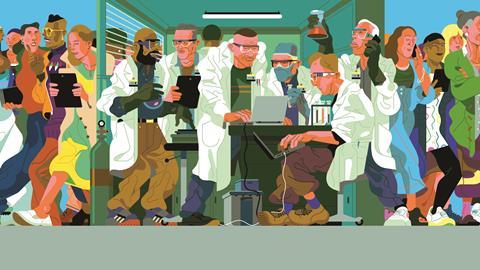

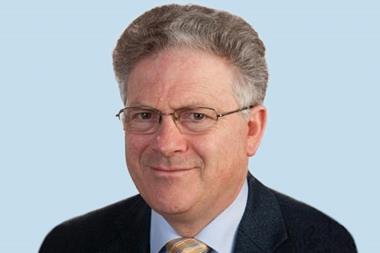
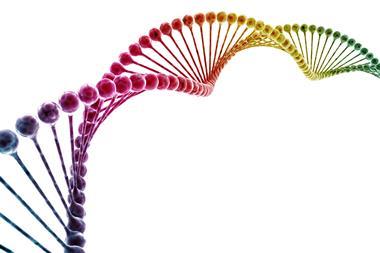
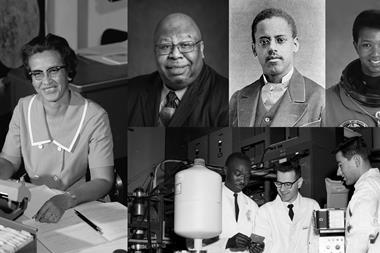

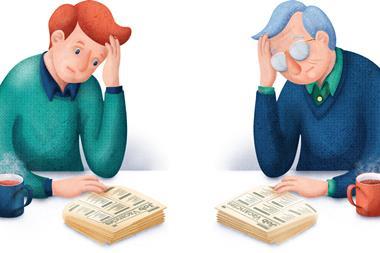






No comments yet